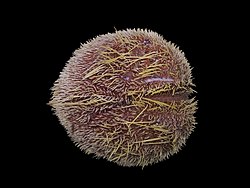This article relies largely or entirely on a single source .(November 2025) |
| Spatangidae | |
|---|---|
 | |
| Spatangus purpureus | |
| Scientific classification | |
| Kingdom: | Animalia |
| Phylum: | Echinodermata |
| Class: | Echinoidea |
| Order: | Spatangoida |
| Family: | Spatangidae Gray, 1825 |
| Genera [1] | |
| |
| Synonyms [1] | |
| |
The Spatangidae are a family of heart urchins. There are three recognised genera within the family; Granopatagus , Plethotaenia , and Spatangus . [1] Additionally, Prospatangus was previously a recognised genus within the Spatangidae, but is now accepted as part of the genus Spatangus. [1]
The Spatangidae are marine heart urchins that feed on subsurface deposits and graze. [1]
